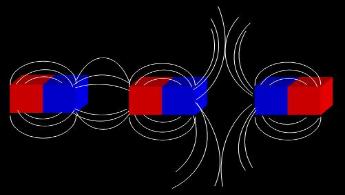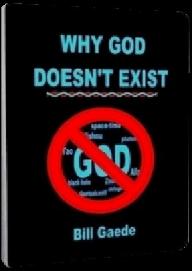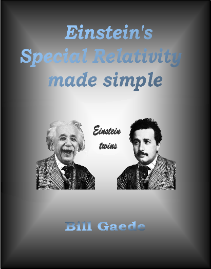
| How a magnet works |
"Does it take you anywhere?" "Sure! Do you want to go for a ride?" "Why not? Let's humor you." The Martian takes you around the block. When you return you ask him with your eyes wide open, "How does it run? Does it run by magic?" "No. It runs just like your cars on Earth. The wheels turn, the tires rub against the pavement and the car moves forward." "What wheels? I don't see any tires? This car is standing in midair!" "Oh, I see what the problem is," explains the little green man. "Here in Mars the tires give off an ultraviolet light. And you earthlings can't see in the UV range. But believe me, the wheels and the tires are there. It works just like a car on Earth." Now that you visualize the invisible wheels and the mechanism, it is no longer magic. You understand exactly how the car moves forward. It was a mystery only until he made the invisible visible. Now it's your turn. You invite the Martian to come to Earth because you have something incredible to show him. He obliges. Back on Earth, you take him to your garage and show him this... |
"How do they work? Do they work by magic?" What are you going to tell him? What explanation are you going to give him? Please make the invisible visible. You can't answer that there is nothing between these horseshoe magnets. Two ordinary horseshoes don't attract or repel one another. Nevertheless, if you say that there is nothing between two magnets then you are indeed invoking magic. And you can't just say that north attracts south or that negative repels negative because that's just a description. You could've just as well have said that X attracts Y and Z repels Z. You have yet no understanding of how Mother Nature's does this trick. Quantum Mechanics replies that there is a magnetic field mediating the transaction... |
There are three problems with this reply... 1. The word field is a concept. There is no physical object called 'a' field any more than there is a physical object called 'an' energy or 'a' mass. The word 'field' invented by Faraday essentially means 'a potential at each point in space'. This definition does not equate to a solid object that can mediate a physical transaction. What if I told you that 'love' draws two magnets together? After all, in poetry we say that "Love moves mountains". Does it make sense to explain physical phenomena with euphemisms and figures of speech? 2. But let's concede for the sake of argument and assume that the 'field' of Math is a physical object. How does 'the' field do it? By what physical process? Please explain in detail how the so-called 'field' causes one magnet to attract the other and repel it when you turn one of the magnets around. How does Mother Nature perform these tricks? How does the 'field' compel the magnets to repel each other in one scenario and to attract in another from a distance? There is no amount of Math that will answer these questions. The only way to answer them is to make the invisible visible! You must do like your Martian host. You must make an ASSUMPTION about the invisible physical entity that mediates the transaction. You MUST propose a physical object and a physical mechanism that simulates magnetic attraction and repulsion. 3. Quantum Mechanics insinuates that the famous 'field' is made of discrete particles. This proposal is consistent with the notion of "a potential at each point in space". Fine! No problem! Now please explain how a bunch of discrete particles scattered around a magnet produce attraction. How does a chunk of iron covered with sand attract another? |

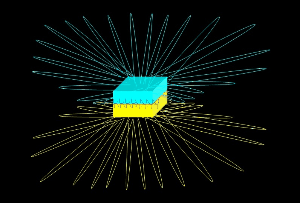
Mars. They are not really kidnapping you. They are simply proud of their planet and want to show a human around. After a week your host asks, "Do you want to see my new car, the one I bought before you came?" "Sure!" The Martian takes you to his garage and you see this... |
| Lines of Force Iron filings align along the 'field' of a magnet because 'a' field consists of countless threads that constantly sweep around the magnet. Without some kind of motion in that invisible 'field' a magnet would not be able to attract another. |
Therefore... 1. You either do magic and claim that 'lines of force', flux, magnetic field lines, domains or whatever you want to call them repulsion with NOTHING, concepts, abstractions... OR 2. You assume that the field 'lines' are physical threads that sweep around a magnet and PHYSICALLY produce attraction and repulsion as explained and illustrated below. |
- In the alternative, you have to forget about Physics and do it with numbers and variables like the
mathemagicians do it. They merely change the sign on the variable from positive to negative and end up
with attraction...
.........."In quantum field theory, even classical forces — such as the electromagnetic...
...........attraction between two charges — can be thought of as due to the exchange of
...........many virtual photons..."
.........."the photon can be created by one particle and absorbed by the other, no matter
...........where they are. If the momentum transferred by the wave points in the direction
...........from the receiving particle to the emitting one, the effect is that of an attractive force."
.........."In the above equation, the potential is negative, denoting that the force is attractive."
.........."The best description of what happens in quantum field theory is that the exchanged
...........particle carries negative momentum - not an easy thing to visualize."
| The theorists of Mathemagics want you to believe that a magnet physically attracts another by throwing particles at it. These particles allegedly deliver 'negative momentum' (i.e., retrograde motion). For instance, quarks are alleged to be kept from drifting away from the protons they form by particles known as gluons. If this isn't magic, then I fail to see what is. Now you know why they call it Quantum Magic. How is this amusing explanation different than the supernatural explanations Greek Mythology offered for unseen causes? |
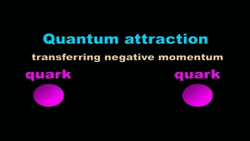
The way of Science...

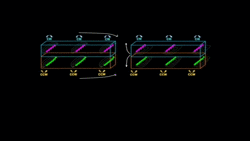
N
S
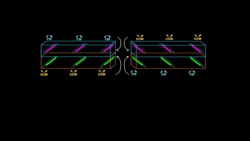
Repulsion
N
try your hand at it >
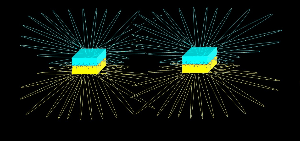
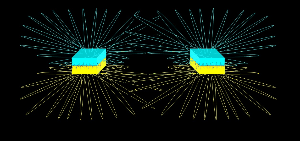
N
S
| Patterns left by iron filing sprinkled around two wires that attract each other |
| Attraction |
Repulsion
N
N
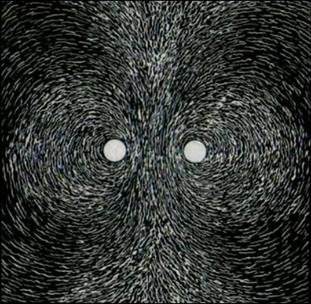
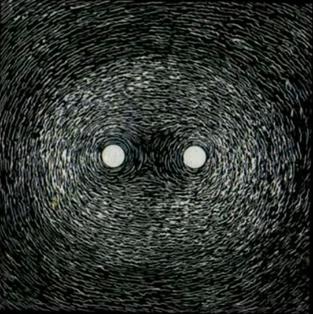
| Patterns left by iron filing sprinkled around two wires that repel each other |
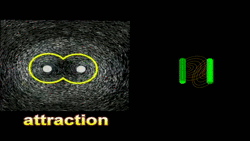
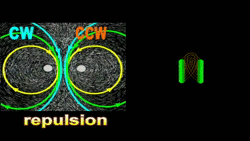
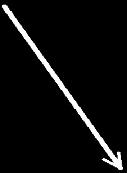

N
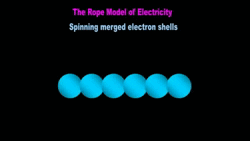
| How a magnet physically attracts another |
| How a magnet physically repulses another |
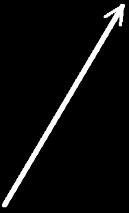
Attraction
| Insane Clown Posse: Fuckin' magnets, how do they work? |
| Patterns left by iron filing sprinkled around two wires that attract each other |
| Patterns left by iron filing sprinkled |
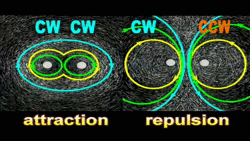
What do we propose in the alternative? We start by proposing that the abstract 'lines of force' that the mathemagicians invoke to justify why iron filings align in the characteristic patterns around a magnet are physical threads that comprise the electromagnetic rope. With PHYSICAL threads we can readily explain how this invisible mechanism moves magnets around. We are no longer talking abstract concepts. We are talking objects! |
| Making the invisible visible: The sand magnets of Quantum and Classical Mechanics |
| Quantum Mechanics proposes that a magnetic 'field' consists of particles: 'a potential at each point in space'. We illustrate this as a chunk of metal enveloped in a ball of sand. The trick is to show how one iron bar would physically attract another under this 'sand' hypothesis. How would the particles do it? |
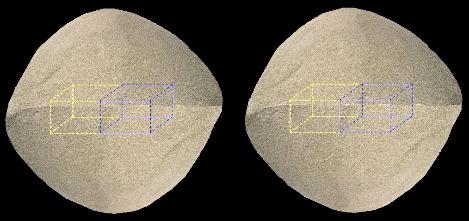
| Repulsion |
The infamous 'lines of force' of Mathemagix are actually PHYSICAL threads that
sweep around a magnet! To attract, the threads of the two magnets act like
interlocking gears that spin in the same direction. To repel, one gear moves
opposite the other like in the old rolling presses or roller drying machines.
sweep around a magnet! To attract, the threads of the two magnets act like
interlocking gears that spin in the same direction. To repel, one gear moves
opposite the other like in the old rolling presses or roller drying machines.

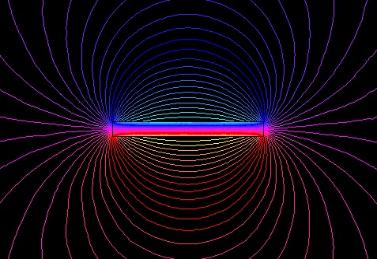
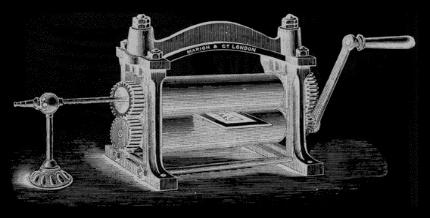
--------------------------------------------------------------------------------------------------------

| The Rope Model of Electricity Spinning merged electron shells |
.
| To comment on any of the pages in this website go to: Rational Science |
